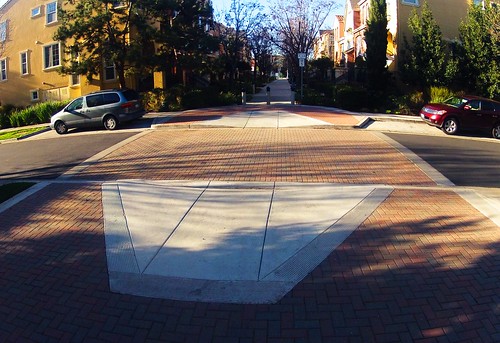I think we can file this under “How many angels can dance on the head of a pin.”
Is this a legal crosswalk in California?

I don’t believe this mid-block crossing on Stewart Lane, Santa Clara, CA fits the definition of a crosswalk in California. Here’s the standard from the 2012 CA MUTCD:
When crosswalk lines are used, they shall consist of solid white lines that mark the crosswalk. They shall not be less than 12 inches or greater than 24 inches in width.
There’s another two full pages of small print providing guidance, support, and options, but no mention that the foot wide solid white lines can be replaced with contrasting strips of concrete and paving bricks.
The Federal Highway Administration even addresses this on their Frequently Asked Questions about the MUTCD:
Q: My city is trying to make the downtown area more aesthetically pleasing and pedestrian-friendly. We are installing brick sidewalks, benches, trees, and other “streetscaping” features along the business district streets. As part of the project, we plan to install brick pavers or other similar treatments to serve as the crosswalks at intersections. Can this type of crosswalk meet the MUTCD requirements?
A: The brick pavers alone would not constitute a legal crosswalk. White pavement marking lines must be used to officially establish a legal crosswalk. As discussed in Chapter 3G of the 2009 MUTCD (Colored Pavements), brick pavers and colored decorative paving treatments that simulate brick or other patterns may be used between the white crosswalk lines. However, colors that degrade the contrast of the white crosswalk lines with the adjoining areas and colors that might be mistaken by road users as a traffic control application should not be used for this purpose. So, for example, the standard colors of red and yellow used for STOP signs and warning signs should not be used, nor should the colors white and yellow used for pavement marking lines. Also, retroreflective colored pavements of any color or pattern are prohibited between crosswalk lines.
Practically, this looks like a crosswalk, and pedestrians and drivers in this neighborhood treat this like a mid-block crosswalk on a very low traffic residential dead end street. Fools and angels can tread safely here, with only the occasional maniac driver rushing too quickly through his own neighborhood.
I’d choose that non-standard crosswalk any day over the majority of crosswalks that meet the MUTCD standard.
Are those rows of white blocks 12″ wide? They may satisfy the requirement.
CVC 21950 is worth noting.
21950. (a) The driver of a vehicle shall yield the right-of-way to a pedestrian crossing the roadway within any marked crosswalk or within any unmarked crosswalk at an intersection, except as otherwise provided in this chapter.
(b) This section does not relieve a pedestrian from the duty of using due care for his or her safety. No pedestrian may suddenly leave a curb or other place of safety and walk or run into the path of a vehicle that is so close as to constitute an immediate hazard. No pedestrian may unnecessarily stop or delay traffic while in a marked or unmarked crosswalk.
(c) The driver of a vehicle approaching a pedestrian within any marked or unmarked crosswalk shall exercise all due care and shall reduce the speed of the vehicle or take any other action relating to the operation of the vehicle as necessary to safeguard the safety of the pedestrian.
(d) Subdivision (b) does not relieve a driver of a vehicle from the duty of exercising due care for the safety of any pedestrian within any marked crosswalk or within any unmarked crosswalk at an intersection.
So, is this an intersection?
Yes, I should have mentioned that stripes are not necessary at intersections (apparently not everybody knows this), and that this is not an intersection.
It *is* a path intersection, but CVC 365 limits the definition of an “intersection” to roads and highways. Paths, driveways and the like don’t count as intersections.